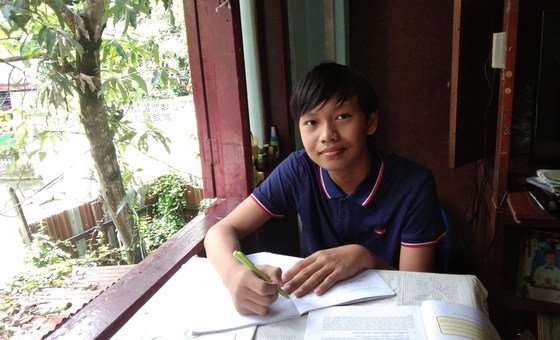Thaw Lay, a high school student from Yangon, the capital of Myanmar, knew that this school year would be unlike any other. “I was excited, but I also knew that things would be a little different, when school reopened later this year”, he recalls.
Thaw Lay and his fellow students face unprecedented levels of disruption to their education: on 21 July, following a slowdown in new local transmissions of the virus, the Ministry of Education announced a phased reopening, starting with high schools.
“From school closures to disruptions in the ongoing reforms, we are facing one of the greatest crises in the education sector today”, said Min Jeong Kim, Head of the UN education agency (UNESCO) office in Myanmar. The COVID-19 pandemic is expected to disproportionately impact the most vulnerable children and youth in Myanmar, exacerbating existing educational inequalities.”
Pencils, pens, masks and shields
Decisions to close or open schools are made according to the COVID-19 Response and Recovery Plan put in place by the Myanmar Ministry of Education, with the support of UNESCO, with the aim of ensuring the continuity of education in the country during and after the pandemic, whilst keeping students and staff safe.
The UN Children’s Fund (UNICEF) supported the Myanmar authorities in the development of guidelines on preventing virus outbreaks in schools, which provide clear messages and information to teachers, student and caregivers to help ensure safe learning environments. More than 90,000 school and learning centres in Myanmar recently received the manual.
During the brief reopening of Myanmar’s schools, additional protocols and safety measures were put in place to ensure the safety of students, teachers and all staff members: free face masks and shields were distributed to every student and teacher, some 75,000 thermometers were provided to schools across Myanmar, and additional hand washing stations were installed.

Students return to school in Myanmar.
Students were told to line up to wash their hands before entering the school compound. Then, teachers would take the body temperature of students, and those found to have a high temperature would either be sent home or taken to the doctor.
Before being allowed to welcome students through their doors, schools were inspected by the Ministry of Education, using a checklist provided by the health authorities to classify high schools under different grades: only those with the highest grade have been allowed to reopen.
For those schools with top marks, additional measures, including double or triple shifts, and alternate days of schooling, were introduced to ensure that physical distancing is observed in classrooms. Adaptations were made to the curriculum to minimize the impact of the pandemic on students’ progression to the next educational level at the end of this academic year.
School’s out
Unfortunately, a second wave of locally transmitted COVID-19 cases put paid to this carefully calibrated solution: at the end of August, the recently-reopened high schools were swiftly ordered to close their doors, and send their students home.
To minimize the learning gap, the Ministry of Education is working with the UN Children’s’ Fund (UNICEF) and other partners to develop home-based learning materials for children and teachers. This will help children to stay engaged in learning and facilitate their smooth transition to the new grade. UNICEF, with support from the Japan International
Cooperation Agency (JICA), is also supporting the printing of home-based learning materials for primary school children to review previous lessons as they wait for the new school year to start.
“For home-based learning, I continue taking part in my lessons through self-study, and our teachers give us assignments to finish at home,” says Thaw Lay.
The Ministry of Education, together with the support of UNESCO, will continue to adapt to the situation, based on the needs of learners, to ensure that when schools reopen again, students like Thaw Lay can return to a safe learning environment in their schools, and that lessons learned from this pandemic, will strengthen the resilience of the education system for future crises.
“The pandemic has challenged all of us in so many ways”, said Ms. Kim. “It is of utmost urgency that we continue our collaboration with the Ministry of Education in support of the COVID-19 Response and Recovery Plan, to find innovative hi-tech, low-tech, and no-tech solutions to ensure the continuity of education for all learners in Myanmar, especially for the most vulnerable children and youth.”

